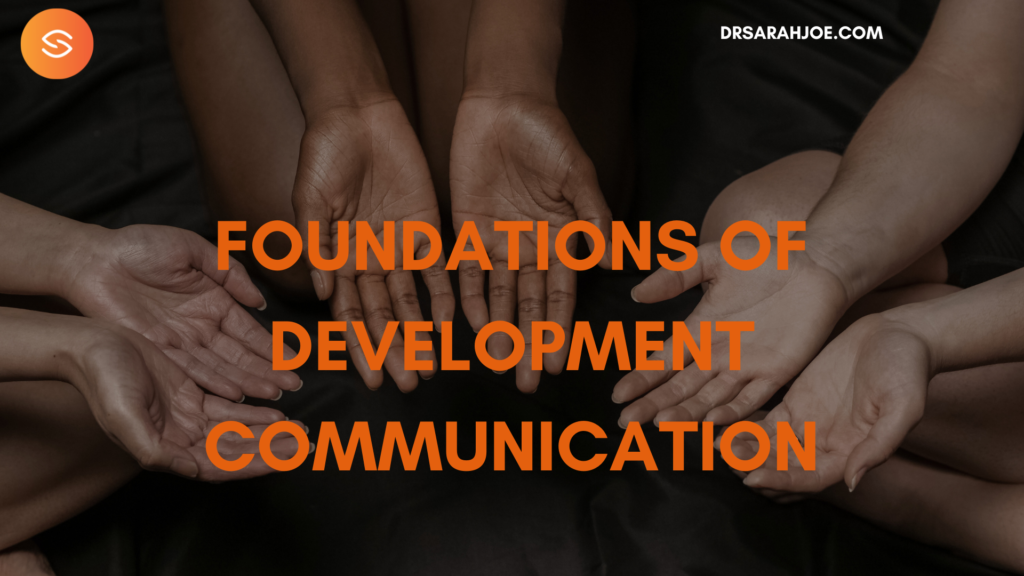The realisation that communication is central to the success of development projects led to the incorporation of Communication as a critical component of all development plans including its introduction as a course of study.
The term Development Communication was coined by Dr. Nora Cruz Quebral (1926-2020), a professor emeritus at the College of Development Communication at the University of the Philippines, Los Banos. She defined DC as: the art and science of human communication applied to the speedy transformation of a country and the mass of its people from a state of poverty to a more dynamic state of economic growth which make possible greater social equality and the larger fulfilment of the human potential (Quebral, 1975).
Development Communication is a field of study and practice that focuses on using communication processes to bring about positive social change, particularly in the context of developing or less developed regions. Understanding its historical perspectives, theoretical frameworks and role in development is crucial for comprehending the evolution of this field.
Development in the past was primarily measured via three indices:
Gross National Product (GNP) – GNP is the total value of goods and services produced by a country’s residents, domestically and abroad. It considers the income earned by a country’s citizens and businesses, regardless of where they are located.
Formula: GNP = GDP + Net income earned from abroad (Net factor income from abroad)
Gross Domestic Product (GDP) – GDP represents the total monetary value of all finished goods and services produced within a country’s borders in a specific period (usually a year). It includes consumer spending, business investments, government expenditures, and net exports (exports minus imports).
Formula: GDP = Consumption + Investment + Government Spending + (Exports – Imports)
Income per Capita (IPC) – Income per capita measures the average income earned by each individual in a specific area, often a country. It is calculated by dividing the total income (GDP or GNP) by the population.
Formula: Income per Capita = GDP (or GNP) / Population
Watch these videos to learn why the GDP is NOT effective for measuring development
The key problem with measuring development economically is that it is too basic and does not really translate to well-being of citizens. This has resulted in alternative development paradigms including:
- Human Development Index (HDI) – The HDI is a composite statistical measure formulated by the United Nations to evaluate and contrast the general well-being and development of countries. It goes beyond economic metrics to calculate three important indicators – Life Expectancy At Birth, Education (Mean Years of Schooling & Expected years of Schooling), Standard of Living (Gross National Income per capita)
- Sustainable Development Goals (SDGs) – The Sustainable Development Goals (SDGs) themselves are not development measurement indicators; rather, they represent a set of global aspirations and targets for sustainable development. The SDGs provide a framework and a shared vision for addressing various dimensions of development, including economic, social, and environmental aspects – No Poverty; Zero Hungry; Good Health and Well-being; Quality Education; Gender Equality; Affordable and Clean Energy; Decent Work and Economic Growth; Industry, Innovation and Infrastructure; Reduced Inequalities; Sustainable Cities and Communities; Responsible Consumption and Production; Climate Action; Life Below water; Life on land; Peace, Justice and Strong Institutions; and Partnerships for the Goals. The SDG is made up of 17 goals, 169 targets, and over 230 indicators for measuring progress. It was adopted in 2015 by the 193 member states of the United Nations. It is designed to run for a 15-year period.
Watch these videos to learn more about the Human Development Index (HDI) and Sustainable Development Goals (SDGs)
Historical Perspectives of Development
Modernisation Theory by Walt Rostow (1950s-1960s):
This theory emerged during the post-World War II period and was based on the idea that societies progress through a series of stages, moving from traditional to modern. Communication was seen as a tool to accelerate this modernisation process.

Watch this video to learn more about the Modernisation Theory
Dependency Theory by Andre-Gunder Frank (1960s-1970s):
In response to Modernization Theory, Dependency Theory emerged, highlighting the exploitative relationships between developed and developing countries. Communication was seen as a means to challenge power imbalances and promote local control over development initiatives.
Watch this video to learn more about the Dependency Theory
Participatory Development (1970s-1980s):
The focus shifted towards participatory approaches, emphasizing the active involvement of communities in the development process. Communication became a tool for facilitating dialogue and empowering communities to express their needs and aspirations.
Critical Theory (1980s-present): Critical perspectives, influenced by critical theory, questioned existing power structures and highlighted the role of communication in shaping discourses and ideologies. It emphasised the need for media to be more inclusive and representative.
Watch this video to learn more about Critical Theory
Theoretical Frameworks of Development Communication
Two-Step Flow Theory:
Introduced by Paul Lazarsfeld and Elihu Katz, this theory suggests that media messages first influence opinion leaders, who then disseminate information to the broader public. It highlights the importance of interpersonal communication in shaping public opinion.
Diffusion of Innovations:
Developed by Everett Rogers, this theory explores how new ideas and technologies spread through societies. Communication plays a vital role in the adoption of innovations, with certain individuals acting as early adopters and influencers. The Technology Adoption Lifecycle inidicates that individuals in any society follow five different adoptor groups.
Innovators (Techies) 2.5% – Early Adopters (Visionaries) 12.5% – Early Majority (Pragmatists) 34% -Late Majority(Conservatives) 34% – Laggards (Skeptics) 16%.
Learn more about the Diffusion of Innovation theory here
Cultural Imperialism:
This theory, associated with scholars like Herbert Schiller, critiques the dominance of Western media and cultural values globally. It argues that the flow of media content from developed to developing countries can contribute to cultural homogenisation.
Framing Theory:
Framing theory, associated with Erving Goffman and later adapted by communication scholars, focuses on how media and communicators frame information to shape public perceptions. In development communication, framing is crucial for influencing how issues are understood and addressed.
Participatory Communication:
Rooted in the works of Paolo Freire and others, participatory communication theories emphasise the importance of involving communities in the communication process. It stresses collaboration, dialogue, and co-creation of knowledge for sustainable development.
Entertainment-Education (E-E) Theory:
E-E theory combines entertainment and educational elements in media content to bring about social change. It recognises that audiences can be engaged and informed through entertaining formats, making it an effective tool for development communication.
Understanding these historical perspectives and theoretical frameworks helps practitioners and scholars navigate the complexities of development communication, adapting strategies to the evolving needs and contexts of the communities they serve.
Democratic Participant Media Theory:
Democratic-Participant Media Theory (Denis McQuail, 1987) – calls for the decentralisation and democratisation of the media – to allow for easy access to channels of communication and the active participation of media audience in the media. That the media should serve the needs, interests and aspirations of the receivers.
Needs, interests, and aspirations of the active receiver in a political society have to do with the right to relevant information, the right to answer back, and the right to use the means of communication in small-scale settings of community, interest group, sub-culture (p. 122).
Develoment Media Theory:
The central argument here is that the mass media have a role to play in facilitating the process of development. That the media can positively influence development. The theory argues that until a nation is well established and its development well underway, media should support and promote national development programmes.
Principles of DMT:
- media must accept and carry out positive development tasks in line with the established national policy
- freedom of the media should be open to economic priorities and development needs of society
- media should give priority in their content to the national culture and languages
- media should give priority to news and information that link with other developing countries, which are close geographically, culturally, or politically
- journalists have responsibilities as well as freedom in their information-gathering and dissemination tasks
- in the interest of development ends, the state has a right to intervene in or restrict media operations, and devices and direct control can be justified
The Role of Communication in Development
Communication plays a pivotal role in the process of development, serving as a catalyst for positive social change, economic progress, and the improvement of living standards. The role of communication in development is multifaceted and encompasses various dimensions:
Information Dissemination:
Communication serves as a primary means for the dissemination of crucial information. It facilitates the flow of knowledge about health, education, technology, and other development-related issues to individuals and communities.
Education and Awareness:
Communication is a key tool in promoting education and awareness. Through various channels such as schools, community programs, and mass media, information can be conveyed to enhance literacy, skills, and understanding of important issues.
Behaviour Change and Social Norms:
Communication strategies can influence behaviour change and shape social norms. Campaigns addressing public health, environmental conservation, or gender equality, for example, aim to alter attitudes and practices within communities.
Community Empowerment:
Empowering communities involves ensuring that individuals have access to information and the ability to voice their concerns. Communication facilitates community participation, engagement, and the development of local leadership.
Technology and Innovation Diffusion:
Communication accelerates the diffusion of new technologies and innovations. By sharing information about advancements, best practices, and success stories, development initiatives can be adopted and adapted more efficiently.
Strengthening Governance:
Transparent and effective communication is crucial for good governance. It enables governments to engage with citizens, share policies and decisions, and receive feedback, fostering a sense of accountability and participation.
Economic Development:
Communication plays a vital role in economic development by facilitating trade, business transactions, and investment. Efficient communication networks and information systems contribute to economic growth and financial inclusion.
Conflict Resolution and Peacebuilding:
Effective communication is essential for resolving conflicts and promoting peace. Dialogue and understanding between conflicting parties, facilitated by communication, can lead to peaceful resolutions and sustainable development.
Crisis Management and Disaster Response:
During crises or disasters, communication is critical for coordinating emergency responses. Timely and accurate information helps mobilise resources, provide assistance, and minimize the impact of crises on communities.
Cultural Preservation and Diversity:
Communication contributes to the preservation and celebration of cultural diversity. It enables the sharing of cultural heritage, traditions, and values, fostering a sense of identity and belonging.
International Cooperation:
Communication facilitates collaboration and cooperation among nations. Global issues such as climate change, health pandemics, and poverty require effective communication for coordinated international efforts.
Advocacy and Social Movements:
Communication is instrumental in advocacy efforts and social movements. Through media, grassroots organising, and online platforms, individuals can mobilise support for social justice, human rights, and environmental causes.
References:
Quebral, N. C. (1975). Development communication. In Jamias, J. F. (Ed.) Readings in development communication. Los Banos: Department of Development Communication, College of Agriculture, University of the Philippines, Los Banos College, Laguna, pp. 1-12.

